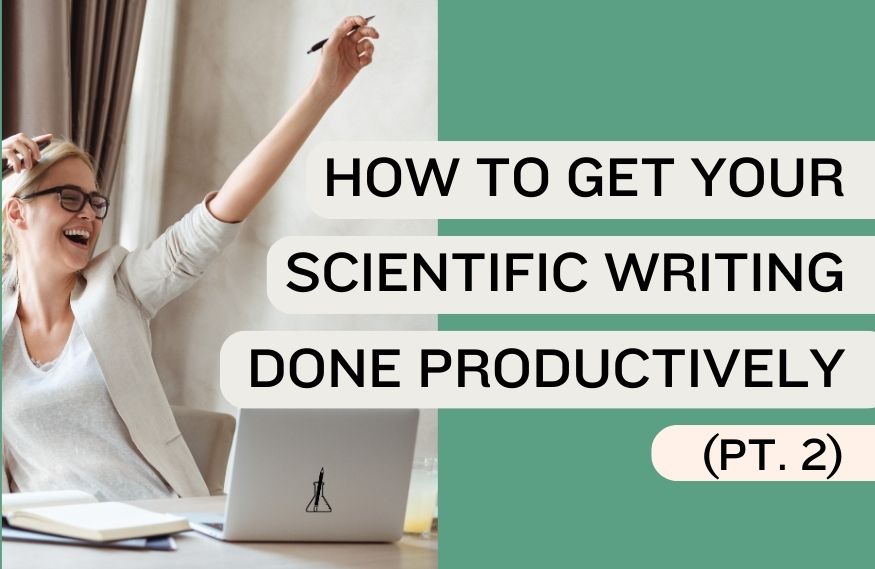You want to get more scientific writing done in less time? Feel like you are always working towards your goals? Or experience how good writing can feel? Then this post is for you.
This is the second and final part of my scientific writing productivity mini-series. If you haven’t yet read the first part, do it now and then come back to this post. This article comes with a free scientific writing productivity toolkit to get you started immediately.
Here are six tips to help you increase your productivity when writing papers and grant proposals:
1. Time block
Have you heard of time-blocking? It’s a game-changer. This strategy goes hand-in-hand with tip number 5 of the first part: finding your ideal writing time. First you need to know what hours in the day you are most focused and creative to work on your paper or proposal.
Then you block out as many hours as you need and have available around that time of the day in your calendar. Rather than spending a whole day writing, I would block out one to three hours a few times in the week. Treat this writing time block like a meeting or lecture you have to hold. Commit and be on time.
2. Track your time
The secret of time-blocking is that you should be clear about what you would like to get done in that time. This requires another skill I briefly mentioned in part I: being able to realistically estimate how long a task will take you. I’m honest with you here, I have struggled with this for a very long time. The only thing that has helped me is to track my time every day for every activity. When I plan a new project, I can just go back to my previous time tracks and plan with a realistic estimate.
There is software available for time-tracking, one example is an app called Toggl. For me, using software is too distracting. It also requires you to remember switching on yet another app and to do so consistently. I simply use my time-blocking calendar and an Excel table to note down the time spent on various tasks.
If you want to try out this method for your writing activities, you can download my scientific writing productivity toolkit below. It contains a ready-made table so you can just go ahead and start filling in the minutes you spent on your different tasks.

3. Write in 25- or 50-minute sessions
It’s easy to forget breaks. The risk with this is that you end up being less productive because you are losing focus without really noticing it. Therefore, I time-block my time during a day in one-hour chunks but devote ten minutes of each hour to a break.
I either set the time on my phone for 50 minutes and break for ten minutes or for 25 minutes and break for five. This depends a bit on how motivated I am to do the task and how much time I need to get into it. The 25/5 sessions are also known as the Pomodoro technique. Check out this blog post if you need help getting started writing.
Setting a timer on your phone has some disadvantages, however. You cannot quickly see how much time is left of your session and by looking at your phone you might get distracted by a notification. As an alternative, you can use a kitchen timer. I’ve also heard good things about TimeTimer but haven’t tried it yet (– let me know what you think when you do!).
4. Eliminate distractions
Once you commit to writing at a certain time of day, make the most out of it. Whenever you get distracted and shift your focus to another task you lose time. Distractions are everywhere so you will need to make an effort to eliminate them. The first thing I recommend to do is to close your email program. (Yes, you’ll be fine not checking your email for a few hours.) Then close all programs and browser windows that you don’t need for writing. In your phone, turn off any push notifications and mute it. If possible, leave it in another room.
If you experience that your colleagues or family members frequently interrupt your writing time, make sure to communicate when you wish to be undisturbed.
5. Reward yourself
The key to writing productively is to feel good about it. I have started to reward myself for hitting my weekly goals with small treats. It works! I’m looking forward to my treat all week and haven’t missed any goals since introducing this strategy.
When your grant proposal was successful or your paper got accepted make sure that you celebrate. Being in academia is a tough job. Be nice to yourself, you deserve it.
6. Be resilient
In this scientific writing productivity mini-series, I have thrown lots of advice at you. You can’t possibly change your habits all at once. Getting into a productive writing rhythm takes time. Start with implementing the advice that makes most sense to you first and see how it goes. If it doesn’t work right away, don’t give up. Simply try it again or tweak it a little until it fits your needs and personality. If you just can’t get it to work, maybe it’s not right for you at this moment. It takes a little time and practice but you will eventually find a productive writing system that works for you. Don’t give up!
There you have it: Six more strategies to stay productive with your scientific writing. If you haven’t yet read my first six productivity tips, check them out here.







